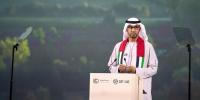Financing Determines Whether COP28 Becomes a Historic Climate Agreement or a Mirage in the Hot Desert Air

Copyright: Duncan Moore, UNEP
At the recently concluded COP28 in Dubai, countries agreed to work towards tripling the expansion of renewable energy, doubling annual improvements in energy efficiency, and implementing a "transition away from" fossil energy. This will require a quantum leap in investments and financing for climate and development, achievable only if governments rethink international cooperation with a focus on partnerships and common interests between the global north and south.
Climate financing takes center stage at every COP, focusing on the rich countries' contributions to the reduction and adaptation efforts of developing nations. At COP28, the primary innovation was the "Loss and Damage Fund," launched with promises of contributions, including from Denmark. As with any COP, several donations to climate funds were announced. In recent years, the focus has been on the rich countries' failure to fulfill the promise made in Copenhagen to mobilize $100 billion annually from 2020 from various sources—a goal that, according to the OECD, is likely to have finally been achieved.
Enormous financing needs by 2030
None of these amounts come close to matching the financing needs for the energy transition and other climate challenges. The decision to transition to clean energy was adopted without clear signals on financing, partly because the COP decision itself acknowledges the need for access to financing, and partly because the major battle for future climate financing will take place next year at COP29, where the successor to the $100 billion goal will be negotiated.
Transitioning to renewable energy (RE) and energy efficiency (EE) is crucial for the climate, and the IMF has recently shown that climate action pays off for most countries, even without factoring in the climate benefit. However, clean energy requires substantial investments, with benefits manifesting over time.
The COP28 decision explicitly mentions global investment needs for the energy transition at $4.3 trillion annually until 2030. Besides China, growth and developing countries are expected to invest $1.5 trillion per year. This is solely energy-related, and the total climate-related financing needs for adaptation, forests, and more amount to $2.4 trillion annually.
Lack of fulfillment of the $100 billion goal by rich countries has understandably strained trust between the north and south and the negotiating atmosphere. However, a breakthrough has gradually occurred towards a new common understanding of the real challenges for investments and financing in climate and development.
The new financing paradigm: Integrated approaches to climate and development challenges
The new paradigm focuses on an integrated approach to development and climate challenges and on investments in energy, adaptation, nature, people, and institutions as the only way to address national and global challenges simultaneously.
Two-thirds of developing countries' increased investment needs must be financed domestically, equivalent to over 5% of countries' GDP. This will only happen if countries experience stable economic development, creating room for savings and investments in both development, climate adaptation, and clean energy.
The remaining third must be financed from international sources, necessitating a "global social contract" or "green deal," advocated by countries like Colombia at COP28.
Rich countries and others capable of channeling savings into investments in developing countries' transition must do so on a much larger scale. Pension funds and other institutional investors, with support from public risk coverage and other incentives—including the removal of regulatory barriers in our part of the world—should invest more in economies experiencing growth and development. With appropriate risk coverage, it is fundamentally attractive because these countries have significant growth potential.
International financial institutions and the entire international "ecosystem" must make a greater and more systematic effort to help countries establish strong institutions and investment-promoting frameworks at both macro and sector levels. Developing countries must, in turn, commit to creating these investment-promoting conditions, which can reduce various risks and thus reduce the costs of financing the transition.
This new paradigm, often referred to as the reform of the "international financial architecture," is reflected in several contexts:
- Several leading economists have contributed reports containing coherent analyses of investment and financing needs in developing countries, proposing ways to finance them with contributions from national and international sources, including concessional financing, loans from development banks, and mobilization of private financing.
- A statement from several countries at COP28 reflects the new approach to climate financing.
- A group of African leaders has committed to an integrated approach to climate and development, focusing on investment and growth.
- Multilateral development banks, spurred by both the G20 and UNFCCC, are undergoing a reform process that includes more direct financing for global challenges, a greater focus on catalyzing private financing, and more systemic collaboration to support countries' transition through country platforms.
Denmark must also increase its financing from public and private sources
This north-south "deal" will require deploying new tools on a large scale, such as state guarantees, which are an effective, flexible, and cost-effective tool for mobilizing private investments and financing. There is also a need to scale up the overall framework for climate and development assistance. The economic report suggests exploring new international financing sources, such as climate taxation on international shipping, and tripling bilateral aid. Even though Denmark is at the forefront, we cannot avoid doing more—and doing it effectively. Every aid dollar—both old and new—must be scrutinized to ensure it has maximum impact on development and climate.
It requires political courage and a willingness to rethink the challenge with a focus on investments in our common future and prosperity. To rise to the challenge, it is about partnership and the recognition of a shared destiny between the north and south: the green growth, prosperity, and development of the global south are also our climate security, conflict prevention—and pension returns.
Originally published in Børsen, december, 2023.

